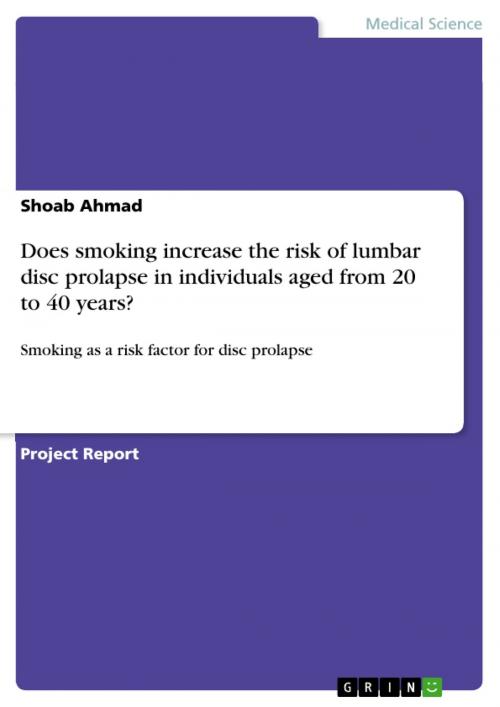Does smoking increase the risk of lumbar disc prolapse in individuals aged from 20 to 40 years?
Smoking as a risk factor for disc prolapse
Nonfiction, Health & Well Being, Medical, Reference, Public Health| Author: | Shoab Ahmad | ISBN: | 9783668223417 |
| Publisher: | GRIN Publishing | Publication: | May 23, 2016 |
| Imprint: | GRIN Publishing | Language: | English |
| Author: | Shoab Ahmad |
| ISBN: | 9783668223417 |
| Publisher: | GRIN Publishing |
| Publication: | May 23, 2016 |
| Imprint: | GRIN Publishing |
| Language: | English |
Project Report from the year 2012 in the subject Medicine - Public Health, grade: 71 H2B, University of Melbourne (School of Population Health), course: Master of Public Health, language: English, abstract: Lumbar disc prolapse is one of the most common neurological conditions and there has been no agreement on its appropriate management. Lumbar disc prolapse is a very common cause of a clinical spectrum of symptoms including back pain, sciatica, knee pain and numbness, and in severe cases, nerve damage and loss of bladder and bowel control. Back pain is the most common symptom of lumbar disc prolapse and is one of the most common conditions for which a patient seeks medical attention. The primary aim of this research project is to design a protocol that estimates the effect of smoking on the risk of lumbar disc prolapse in individuals aged from 20 to 40 years. Background Evidence suggests that smokers have a 3-4 times higher risk of developing disc disease and that smoking can exacerbate pre-existing disc degeneration. Nicotine and other harmful toxins in cigarette smoke prevent nucleosus pulposus and annulus fibrosus cells from up taking nutrients. This can cause significant inhibition of cell proliferation and extra cellular matrix synthesis, making disc injury more likely and recovery from an injury slow. While there is strong evidence in the literature that smoking does have a role in the pathogenesis of lumbar disc prolapse and back pain, there are no accurate estimates of the magnitude of the increased risk. Methods Different analytical study designs were evaluated to assess their strengths, limitations and feasibility for answering the research question. Issues of subject selection, bias and measurement were assessed for case-control and cohort study designs. It was concluded that the most epidemiologically robust design would be a case-control study, which was chosen for its efficiency in time and cost. Conclusion A case-control study is the best design to realise the primary aim of this research protocol. Conducting the study across Australia will enable enough cases to be identified and recruiting controls from the neighborhood of the cases with simple enrolment requirements will increase the response rate and minimise the bias. Exposure measurement through face-to-face interview by trained interviewers using a structured questionnaire is cost efficient, and the use of trained interviewers ensures that participants understand the questions clearly.
Project Report from the year 2012 in the subject Medicine - Public Health, grade: 71 H2B, University of Melbourne (School of Population Health), course: Master of Public Health, language: English, abstract: Lumbar disc prolapse is one of the most common neurological conditions and there has been no agreement on its appropriate management. Lumbar disc prolapse is a very common cause of a clinical spectrum of symptoms including back pain, sciatica, knee pain and numbness, and in severe cases, nerve damage and loss of bladder and bowel control. Back pain is the most common symptom of lumbar disc prolapse and is one of the most common conditions for which a patient seeks medical attention. The primary aim of this research project is to design a protocol that estimates the effect of smoking on the risk of lumbar disc prolapse in individuals aged from 20 to 40 years. Background Evidence suggests that smokers have a 3-4 times higher risk of developing disc disease and that smoking can exacerbate pre-existing disc degeneration. Nicotine and other harmful toxins in cigarette smoke prevent nucleosus pulposus and annulus fibrosus cells from up taking nutrients. This can cause significant inhibition of cell proliferation and extra cellular matrix synthesis, making disc injury more likely and recovery from an injury slow. While there is strong evidence in the literature that smoking does have a role in the pathogenesis of lumbar disc prolapse and back pain, there are no accurate estimates of the magnitude of the increased risk. Methods Different analytical study designs were evaluated to assess their strengths, limitations and feasibility for answering the research question. Issues of subject selection, bias and measurement were assessed for case-control and cohort study designs. It was concluded that the most epidemiologically robust design would be a case-control study, which was chosen for its efficiency in time and cost. Conclusion A case-control study is the best design to realise the primary aim of this research protocol. Conducting the study across Australia will enable enough cases to be identified and recruiting controls from the neighborhood of the cases with simple enrolment requirements will increase the response rate and minimise the bias. Exposure measurement through face-to-face interview by trained interviewers using a structured questionnaire is cost efficient, and the use of trained interviewers ensures that participants understand the questions clearly.















